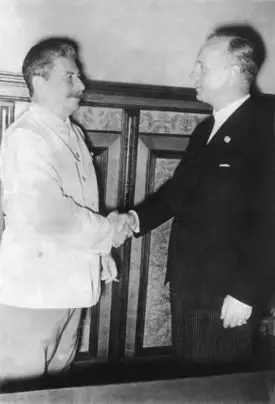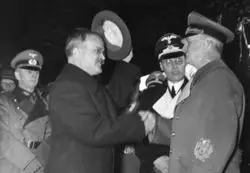The Molotov-Ribbentrop Pact- Stalin’s greatest mistake
On August 23, 1939, Hitler and Stalin signed a non-aggression treaty, popularly called the Molotov-Ribbentrop Pact. It shocked the world. The two countries were bitter ideological enemies and many expected a war between the two to be imminent. Instead, they had pledged not to attack each other. They had gone from sworn enemies to allies in the space of months. This article will discuss the impact of this diplomatic agreement on Europe and on the origins of the Second World War. It will argue that the pact was a strategic mistake by Stalin and it allowed Nazi Germany to take control of western Europe and this gave them to strength to attack the Soviet Union.
Background
In 1939, the Soviet Union was something of a ‘rogue’ state.[1]. It had little or no relations with the western power, who suspected Moscow of trying to spread Communism throughout the world. Despite being ideological rivals, Nazi Germany, and the Soviet Union began secret negotiations in 1939. The situation in Europe was tense and many expected another general European war. They were conducted in secret and were overseen by the foreign ministers of the respective countries. In 1939, the Pact was announced by the foreign ministers of Germany (Ribbentrop) and of the Soviet Union (Molotov). The Ribbentrop- Molotov pact, named after the negotiators, as it came to be known, was composed of two parts, a public agreement, and secret protocols.[2] Publicly, the pact stated that Nazi Germany and the Soviet Union would not engage in any aggressive actions towards each other. The parties to the agreement stated that they would not go to war with each other.
Much of the Pact was secret. The reasons for this was that it allowed both Hitler and Stalin’s regime to further their national and strategic interests.[3] In fact, many of the protocols were denied by the Soviets until 1989 and the fall of the Berlin War. The secret protocols involved dividing up eastern Europe into separate spheres of influence. Poland was to be divided between Germany and the Soviet Union. The Soviet Union was allowed to take control of the Baltic States and Bessarabia (now Moldovia). More importantly for the Soviet Union was the fact that Stalin did not want a war and some have speculated that he wanted Hitler and the Western Allies to fight each other and weaken themselves until their states were ripe for a Communist takeover.[4]. Another possible reason for Stalin signing the Pact with his ideological enemy was that he feared an attack from Japan in the East.
Invasion of Poland
The agreement between Hitler and Stalin meant that the Nazi state was free to pursue its interests in Poland. Hitler wanted ‘living space’ in the east, to enable the German nation to grow and expand and to fulfil the destiny of the ‘master race’. Hitler was intent on wiping out Poland. There were tensions between Warsaw and Berlin over the city of Danzig and areas in Poland where German speakers were a majority.[5] Hitler used these tensions as a pretext to invade Poland. He wanted to conquer the country and remove it from the map of Europe. The Molotov-Rippentrop Agreement, allowed Hitler to attack Poland because he knew that Stalin would not intervene to stop his plans. In September 1939, Hitler’s forces invaded Poland and later, when the Poles were on the verge of defeat, the Soviets invaded eastern Poland.[6]. The Nazi invasion of Poland led to the western allies, France, and Britain declaring war on Germany and the start of WW II.
Strategic Implications
The Pact delivered enormous strategic advantages to the Germans. The Pact allowed them to concentrate their attacks on the western allies. They did not have to divide their forces and fight a war on the western and the eastern front. In 1914, Germany had been forced to divided its forces and this slowed down its advance in the west and possibly cost them a swift victory. This was not the case in 1939, the German war machine could concentrate on its western rivals. Freed from any threat from the east, by the agreement with Stalin, the German army launched a Blitzkrieg on western Europe. Soon Norway, Denmark, the Netherland, Belgium and France fell to the Nazis. It is highly unlikely that this would have been possible if the German’s had been forced to fight a war against the Soviet Union. The Pact neutralized the Soviet threat from the east. The Ribbentrop- Molotov pact had allowed Hitler to become the master of Europe and Stalin must have begun to wonder if he had not made a strategic mistake. However, he continued to hold to the terms of the Pact, as he feared a war with the German War Machine.[7]
The end of the Pact
Hitler had always made clear that he considered the Soviets as his greatest enemy. However, Stalin was lulled by the Pact, into believing that Hitler would never attack his territories.[8] There had been many indicators that the Nazis were preparing for an invasion of the Soviet Union. The German forces had been building up in Western Poland and elsewhere. Stalin refused to believe that evidence that his desperate Generals presented him with. He even refused to order a general mobilization of the Soviet Divisions. In fact, Stalin even permitted the export of important raw materials to Nazi Germany right up to the outbreak of hostilities.
Nazi Germany ended the Molotov–Ribbentrop Pact June 1941 by launching a massive invasion of Soviet territory. Stalin, when he heard that the Germans, had invaded and that the pact was no more and irrelevant went into a state of shock. He apparently went into hiding for several days, during which time the Soviet Union was left leaderless. Stalin had apparently gained very much for the pact however, he had really been duped by Hitler. The Pact had served Hitler very well it had allowed him to attack first the west and defeat the British and French. When he was completed he was able to invade the Soviet Union.[9].
Conclusion
The Molotov-Ribbentrop Pact was apparently a triumph for Stalin. He was able to secure large swaths of territory that had once been part of the old Tsarist Empire. It also secured his western borders against attack. Stalin Pact allowed the Germans to dominate Europe and then allowed them when they were strong enough to attack the Soviet Union, with the real possibility of success. The Pact was in fact, his greatest mistake and one that nearly led to the defeat of the Soviet Union and this would have led to the victory for the Nazis in Europe.
References
- ↑ Bendersky, Joseph, A History of Nazi Germany: 1919–1945 (Rowman & Littlefield, London, 2000), p. 78.
- ↑ Bendersky, p. 56.
- ↑ Moorhouse, Roger. The Devils' Alliance: Hitler's Pact with Stalin, 1939–1941. (The Bodley Head. London, 2014), p. 78
- ↑ Bendersky, p. 66
- ↑ Moorhouse,p. 178
- ↑ Davies, N. God's Playground(Oxford University Press. Oxford, 1986, p. 187), p. 213
- ↑ Taylor, AJP. The Origins of the Second World War (London: Simon & Schuster. 1961), p. 111
- ↑ Taylor, p. 134
- ↑ Davies, p. 77

